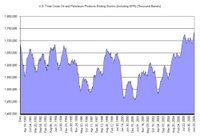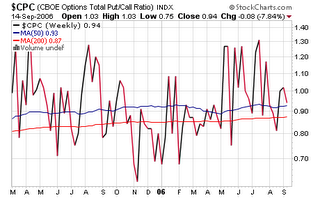


As we have witnessed over the last 6 weeks , crude oil has fallen from $78/bbl . down to $63/bbl , a rapid decline and a major factor leading to the rally in Equities and Bonds . While we are happy to see retail gas prices falling from $3/gallon to $2.55/gallon at the pump , we shouldn't get overly optimistic that oil continues to fall towards $40/bbl. anytime soon.
This week the IEA cut worldwide Oil demand to 84.7 Million bbl./day for the balance of 2006 , down from a previous estimate of 84.8 Million bbl./day made last May , and its 2007 daily Oil estimates was cut by 160 Thousand to 86.2Million bbl. /day --- not exactly huge declines . Recently OPEC cut worldwide demand estimates as well , also by token accounts .OPEC, which controls 40% of the world's crude, opted to keep its production quota at 28 million barrels per day to help lower prices and has maintained that level since July 2005 . For 2006 , OPEC expects demand growth in the U.S. to grow by only 90,000 barrels per day. In 2005, growth jumped by 230,000 barrels per day and in 2004 the growth was 520,000 barrels per day .
The increase of supply output , prospects of new Oil reserves in the GofM , and no Hurricane-related dislocations , have kept Crude and Gasoline prices under enormous pressure recently . BUT , that doesn't necessarily mean that the Demand side of the equation is fully eliminated . The U.S. consumer is still "addicted" to oil and Chinese demand is not going anywhere soon .
One way to look at the supply side is Total Oil crude and products in inventory which points to relatively high levels , but a better gauge to look at is the supply in storage needed to cover existing demand . In 1991 we had approximately 65 days of supply to cover demand , but in 2006 the supply is down to a lower level of 50 days supply to cover daily demand .
Don't throw away your bicycle just yet

 S&P 500 profit growth for the third quarter came in around 20% versus a long-term historical average of 7%, according to Thomson Financial. This marks the 17th straight quarter of double-digit profit growth, the best streak since recording keeping began in 1936.... another great quarter for corporate America and for equities
S&P 500 profit growth for the third quarter came in around 20% versus a long-term historical average of 7%, according to Thomson Financial. This marks the 17th straight quarter of double-digit profit growth, the best streak since recording keeping began in 1936.... another great quarter for corporate America and for equities
 Mid-Cap Index has returned 8.62%/year .
Mid-Cap Index has returned 8.62%/year .



 As we have witnessed over the last 6 weeks , crude oil has fallen from $78/bbl . down to $63/bbl , a rapid decline and a major factor leading to the rally in Equities and Bonds . While we are happy to see retail gas prices falling from $3/gallon to $2.55/gallon at the pump , we shouldn't get overly optimistic that oil continues to fall towards $40/bbl. anytime soon.
As we have witnessed over the last 6 weeks , crude oil has fallen from $78/bbl . down to $63/bbl , a rapid decline and a major factor leading to the rally in Equities and Bonds . While we are happy to see retail gas prices falling from $3/gallon to $2.55/gallon at the pump , we shouldn't get overly optimistic that oil continues to fall towards $40/bbl. anytime soon. 


